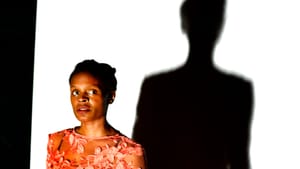Stay in the Loop
BSR publishes on a weekly schedule, with an email newsletter every Wednesday and Thursday morning. There’s no paywall, and subscribing is always free.
Must-see TV
Bryn Mawr College presents Okwui Okpokwasili's 'Poor People's TV Room'

Award-winning performance artist Okwui Okpokwasili brought her newest work, Poor People’s TV Room, to Bryn Mawr College for a two-night stop in a six-city tour. The school makes a logical venue for this multidisciplinary work combining dance, text, music, and live video. It would also find a receptive audience in Philadelphia’s annual Fringe Festival, where Okpokwasili's Bronx Gothic played in 2016.
This 2017 collaboration with director and visual designer Peter Born was inspired in part by the Nigerian Women’s War of 1929. The piece doesn't provide narrative background about that incident, but is rather a visceral response to violence against women and depiction of women using their bodies and voices in protest. She also alludes to contemporary movements such as “Bring Back Our Girls,” an international response to the 2014 Boko Haram kidnapping of more than 300 schoolgirls.
Abstract at first sight
Born’s design is striking, and the four dynamic performers use it well. Plastic sheeting curtains the upstage area. Furniture hangs above a platform at a 90-degree angle. A ceiling camera faces down, its live feed projected on a screen. When actors lie on the platform, the screen shows them standing in the room.
This realistic set, on a stage otherwise nearly bare, is also mind-bending. We simultaneously see performers lying on the platform and standing up onscreen. Perhaps it’s a test; do we trust what we see live, or what’s broadcast to us?
It’s a neat trick, but the intensity of what occurs there really makes it special. A miserable rich woman (Okpokwasili) verbally brutalizes her House Girl (Thuli Dumakude): “What is less than shit in value?” A nearly invisible servant is her answer, of course, but the woman still needs the girl, even suckling from her breast.
Nehemoyia Young and Katrina Reid discuss “a time way back when Oprah was a human being” and reference the ironically jolly quotations on poor Africans’ discarded American t-shirts: “You Had Me at Pizza,” “Make 7-Up Yours,” even “In Oprah We Trust.” Oprah’s visage manifests on toast and in other unlikely places, they tell each other. “Make me visible!” they pray to America’s beloved celebrity.
Levels blend
While I’m inclined to notice words and realistic actions foremost, much of the power and beauty of Poor People’s TV Room emanates from the cast’s chanting, singing, dancing, and stylized movement. Dark images abound, but their consistent underlying theme is perseverance despite all obstacles.
The culmination of Poor People's TV Room is a powerfully staged literal and figurative breakthrough that caps the emotionally draining 90-minute performance with an energizing burst of hope. Women in Nigeria, and all over the world, persist.
What, When, Where
Poor People’s TV Room. By Okwui Okpokwasili and Peter Born, Peter Born directed. February 23-24, 2018, at Bryn Mawr College's Hepburn Teaching Theater, Goodhart Hall, 101 N. Merion Avenue, Bryn Mawr, Pennsylvania. (610) 526-5210 or brynmawr.edu/arts.
Sign up for our newsletter
All of the week's new articles, all in one place. Sign up for the free weekly BSR newsletters, and don't miss a conversation.

 Mark Cofta
Mark Cofta